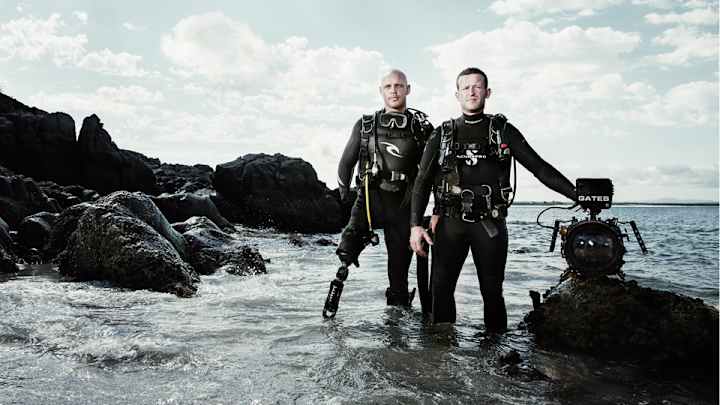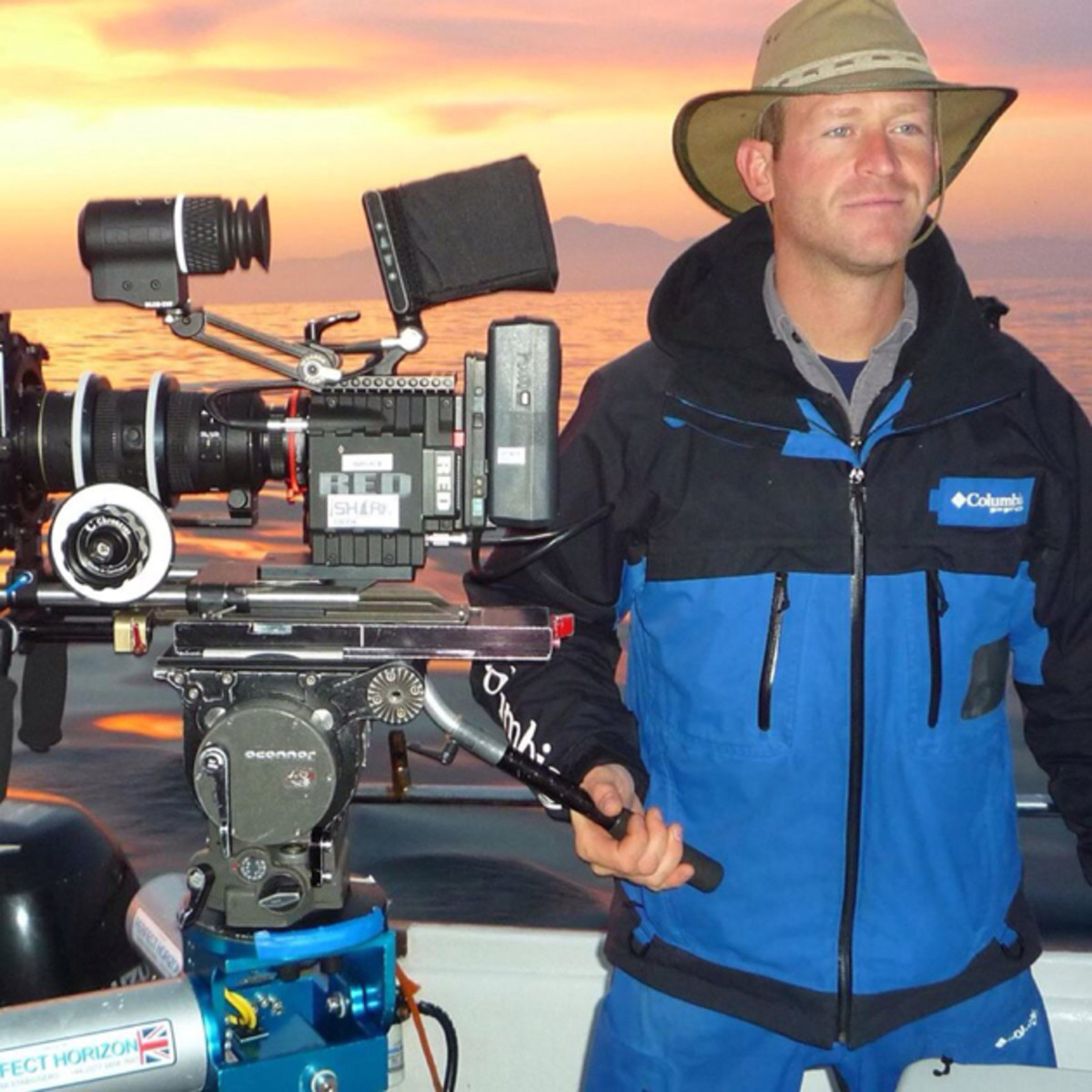Talking Shark Week with stars of the 'Great White Matrix'

Ever wonder what it's like to swim with the sharks? Australia-based shark attack survivor, Paul de Gelder, and daredevil cameraman, Andy Casagrande, have teamed up for the sake of the sharks for Discovery Channel's new show, Great White Matrix, and Edge got the inside scoop on the duo's adventures and the making of the show. In an adrenaline-packed documentary featuring up-close-and-personal photos and footage of sharks, de Gelder (who was a guest trainer on The Biggest Loser) and Casagrande (who also shot Zombie Sharks and other wildlife films) push the envelope using advanced camera technologies and passion for thrilling, under-water experiences.
What made you decide to be a Navy diver?
Paul: I was a pretty good kid until 15. I started drinking, smoking, partying. I became more and more distant with my family. I was setting a bad example for my younger brothers and I got kicked out of the house. I realized that I had to change or I was going to be dead or in jail by 23 years old. So I removed myself from the environment, but then I repeated the cycle. I called my mom—like we do when we are lost—and I talked to my younger brothers who were in the army.
That’s where it started—I became an army paratrooper. I did deployments with the UN, sniper courses, urban warfare, jungle warfare and parachuting. But then I got bored. I wanted more adventure. So I applied to become a Navy clearance diver, similar to [the U.S.] Navy Seals. I had to go through the selection process. We got smashed nonstop for 10 days. Five mile swims in the middle of night, the stuff just destroys you. But I survived.
Can you describe the shark attack in 2009?
Paul: I was a Navy clearance diver for just over four years. I was 31. What we were doing was a counter-terrorism exercise and I was swimming on my back along the surface in the waters in Sydney Harbor, near the Opera House. I was only in the water for five minutes, then I felt this big wack on my leg—I didn’t think much of it at first because it didn’t hurt. But then I saw the bullshark and it was literally my worse nightmare. I stared eye-to-eye with it for a few seconds trying work out what to do. I said to myself, “I’ve seen Shark Week, I’ve seen Crocodile Hunter, I’ll just hit him in the eyeball.” But it had my hand so I couldn’t, and I tried to push it off and punch it, but it took me under and started tearing my leg apart. It tore off my hamstring and my right hand. I popped to the surface and starting swimming for all my life. When my right arm came out of the water I saw that my hand was gone. I kept it above my heart and kept swimming until the guys in the safety boat came over to me.
Just found the wetsuit I was wearing when I was attacked by a shark. pic.twitter.com/RBz33Kdk
— Paul de Gelder (@PauldeGelder) August 9, 2012
In the hospital you did one-armed chin-ups right after the attack. Why was getting your strength back so important to you?
Paul: I couldn’t get out of bed. It was two days after my leg was cut off and I was laying in my bed saying, “What am I gonna do now?” It turned into a simple choice. Do I want a good life or bad life? I could have played the pity card or I could do what the military trained me to do and pick myself up and choose a good life.
How do you test your fitness today?
Q+A with Actor and Race Car Driver Patrick Dempsey
Paul: I was pretty fit beforehand. And now I’m super fit still, just in a different way. I’m stronger and bigger because I don’t need to focus on long swims and runs in the middle of the night. Now it’s endurance but also strength for the tasks that my life incorporates now with moving around boats and moving equipment. Part of my job as a motivational speaker is to inspire, so I try to lead by example.
I go to the gym, go swimming and running occasionally. Anything that gets my heart racing. My training is always evolving. Sometimes its really heavy weight, or lots of reps; high intensity interval training and bodyweight workouts like pushups and chin-ups. You have to continually evolve to shock the body into growth and strength.
I can’t run any further than six miles because then the sweat makes my running leg come off and the silicone liner that holds on my running blade and it exposes my skin to the hard plastic socket and it rubs my skin off. I do short distances more often, or hill sprints. For me anything is fitness. Just getting out and going to the gym or going for a surf—I’m not an indoors guy.
What do you want people to learn from the show?
Paul: I really learned how important sharks are to the oceans’ ecosystem and our planet and now that I have a voice I need to use that to speak up for the sharks, who don’t have a voice. This show has adventure and science and excitement and it’s real—nothing about it is fake. We show the animals to the people and give them information so they can learn to love and respect them as much as we do.
Andy: The basic premise of the show is that we want to document baby great white sharks and how they mature into adults. The twist is finding out at what point do they become dangerous. It’s all based on biology. As they get bigger, they need to consume more calories, their jaws calcify and their teeth get serrated and rotten so they can eat seals, dolphins and tuna. And that’s when they start to make mistakes.
The sharks are just trying to survive. The babies aren’t really a threat, and the big ones aren’t really either. It’s a pretty scary situation to think about getting bit or eaten alive, and sharks are dangerous but not malicious. They’re not really out to get us. Big great whites make mistakes when they are at the tipping point where they are still learning and going from eating smaller to bigger prey. Humans are mammals as well and we live and breathe at the surface, just like their prey. They look at the silhouette and the things splashing around and they can get confused.
What does it take to film something like this?
Andy: It’s something I’ve been doing for over a decade now—sharks are amazing animals and they are dangerous, but they are not malicious. You need to be physically fit and also mentally prepared. I took a free diving course to help increase my breath hold. You get the best scuba diving equipment you can so you don’t have to worry while you’re under the water. And it’s such an amazing time for the technology, the cameras are getting smaller and stuff. So we have GoPros and Red Epic cameras, which are big, hefty cameras but they shoot James Bond and Pirates of the Caribbean and all of the Hollywood films. We use a cool Matrix-style camera with 22 different Go Pros on it, to try to inspire people through cool images of sharks.
And I also use those as my protection. If the shark tries to bump me and they try to bite something they bite the camera, and they realize its inedible because it’s metal, they stay away.

Have you ever had any bad encounters with the sharks while filming?
Andy: I’ve had plenty of close calls, but I’ve never been bit. I’ve had my fins nibbled on. And they have chased me out of the water a few times, but I’ve never been bit.
What is your best advice for surfers or other adventurers exploring the oceans?
Andy: Use common sense. If you are in murky water—surfing or swimming—it gives the shark more of an opportunity to mistake you for something else because you are obscured by bad visibility. I’m not trying to deter people from surfing. For the most part if you leave them alone you’ll be fine.
River mouths is where sharks congregate because things tend to wash up there, so if you avoid them, you decrease the opportunity of encountering a shark. If you’re spearing fishing, don’t carry your fish on your waist belt. Then you’re just like a walking target.
And what if the shark tries to bite?
Andy: Most people have heard that you hit the shark on the nose, but the nose is actually pretty robust because they are used to swimming and bumping into the reef, ramming into other sharks. The eyes and gills are the most vulnerable components. If you get the gills they can slow down or they can loose vision and then they can’t hunt.
If you encounter a shark, rake at its gills and the eyes and most likely it will let you go. Maintain eye contact and don’t panic because if you act like prey, they will treat you like prey and will chase you. They are used to hunting things down that swim away from them. Try to make your exit strategy as peaceful as possible. You’d be surprised how easy it is to deflect a shark—almost like a matador with a bull.
You can check out Great White Matrix when it premieres during Shark Weekon August 16.
